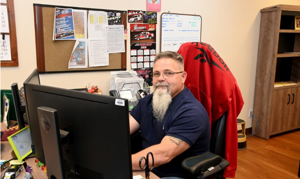
13 Mar Upward mobility: Marine Corps veteran finds variety, rewards working at Yuma Proving Ground
YUMA — Now in his 36th year at U.S. Army Yuma Proving Ground (YPG), Marine Corps Veteran Jose Ramos has spent decades testing for the best.
Born in Lisbon, Portgual, Ramos’ family came to the United States when he was 11 years old.
He loved his new country, and thrilled at John Wayne movies: he says they inspired him to enlist in the Marine Corps when he came of age. After basic training at Camp Lejune, he was stationed at New River, then South Korea, and finally Marine Corps Air Station-Yuma. During his time active duty, he was only vaguely aware of YPG’s existence.
“Sometimes I used to like to drive and listen to music, so I would take Highway 95 and I would stop at the big guns. I never made that left turn into YPG.”
He married his wife Tammy in 1985, and when his enlistment was up they moved back to New Jersey and had two children. There stay was brief, however.
“I came back because my wife is from Yuma and her family was here. She didn’t like the cold.”
In 1987, his wife’s brother, Rick Douglas, a longtime test officer at the proving ground, told him about a job opening in the conditioning chambers section.
“Within two weeks we’d packed everything up, sold our house, and moved down here.”
After three years at YPG, he was working in the proving ground’s motor pool, delivering scores of different test items to points all across the proving ground’s vast test ranges and beyond. The tools of the motor pool’s trade are a variety of tractor trailers and flat beds, and tactical wreckers to transport towed howitzers. Ramos’ experience over the next dozen years made him an ideal candidate to become a test vehicle operator.
“I had acquired all of these licenses because I used to have to take all of the tanks and artillery pieces downrange for the gunners.”
Over the next dozen years, he became known for his specialized experience driving M1 Abrams Main Battle Tanks.
“I love the M1s—they’re near to my heart because I’ve done a lot of work with them. As test driver, test lead, and test coordinator.”
Prior to the first Gulf War in the early 1990s, the life-expectancy of the tracks used to propel an M1 Abrams Main Battle Tank along the ground was measured in the hundreds of miles. After extensive testing at U.S. Army Yuma Proving Ground, today’s tank treads last for thousands of miles. Proving out the upgrades was hard labor driving along hundreds of miles of desert road courses in the intense Yuma heat.
“My back hurts a little bit. It took a bit out of me.”
His knowledge of the system also led him to support tests in places like Dugway Proving Ground and YPG’s Cold Regions Test Center, where he spent most of six months driving the M1 in the intense Alaskan cold, with only a two-week break around Christmas time.
“When we left it was -35, when we got back the first week in January it got down to -49.8. It was a good experience.”
He became a test coordinator for M1s for two years until a job as a range control specialist became available.
“I like challenges—that’s why I keep moving.”
Most divisions at Yuma Proving Ground are fast-paced, but few rival the Range Operations and Training Division in terms of the sheer scope of responsibility and volume of work. Responsible for coordinating safe operations of numerous inherently dangerous test activities in a geographic area that is larger than the state of Rhode Island, every individual and group heading out to test on YPG’s ranges must get clearance from the range controllers before they can proceed to their destination. On a busy day, this can mean upwards of 250 phone calls for range clearances, with an equal number of calls to cancel them at the conclusion of the day.
Seven years into his current role, Ramos still derives great satisfaction from working on behalf of the warfighter.
“This is my adopted country and I wanted to give back. That’s why I joined the Marine Corps when I was young, and I think I’m still giving back.”
